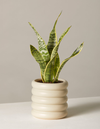This Popular Household Plant Is Virtually Impossible to Kill, Says an Expert
Here’s how to make it thrive.
Updated Oct 11, 2018 9:34 PM
We may earn revenue from the products available on this page and participate in affiliate programs.
Named for how its verdant leaves resemble the slithering reptile, the snake plant has been a long-beloved accent in the corners of living rooms or the centers of side tables for many years. As green thumbs continue to shape the conversation around modern pops of color and texture, the snake plant is still a standout choice for its ability to thrive in even the most neglectful conditions.
“The snake plant is incredibly resilient and can handle a wide range of light conditions,” says Erin Marino, director of brand marketing at The Sill. “That makes it a great pick if you’re purchasing a gift for someone.” It doesn’t need special soil. It won’t guzzle a lot of water. And it can make itself at home in low-light spaces and brightly lit environments alike. In other words, it’s the type of present you get someone when you’re looking to cover all your bases.
But if we may add one small asterisk before you wrap a big red bow on this universally appealing gift, it’s to also give your loved one a few tips on how to care for a snake plant. From its watering and soil needs to which environment it thrives in, Marino’s advice can be written down in a card or shared in person once the plant is settled in its new address. When you learn these lessons, you should probably gift yourself a snake plant, too.
Know the Facts
“The snake plant, or Sansevieria trifasciata, is a tropical plant that is also a succulent,” says Marino. “Like other succulents, it has a modified form of photosynthesis, in which it opens its pores exclusively at night to preserve water. Since photosynthesis only happens with daylight, the snake plant stores the carbon dioxide it acquires at night for use during the day. It releases oxygen at night when its pores open.”
Use Typical Soil
“Regular indoor potting mix does the trick,” she notes. “Opt for a planter with drainage holes and a saucer, or line the bottom of your plant with lava rocks to create crevices for excess water to drain.”
Water Sparingly
“Because the snake plant has succulent characteristics, you’re looking at watering it about once every two to three weeks in medium, indirect light,” Marino explains. “You should water more frequently in the spring and summer months, when there’s brighter light, and less frequently in the fall and winter months, when there’s lower light. If you’re wary of overwatering, you can wait for its usually stiff leaves to start to wrinkle—that’s a sign of thirst.”
Find Just Enough Light
“Often considered to be a low-light plant, the snake plant actually thrives in medium-to-bright indirect light,” she says. “It can definitely tolerate low light, but prefers a bit more sun if possible.”
Give It the Right Company
“If you plan to keep your snake plant in medium-to-low indirect light, pair it was a plant that’s equally drought tolerant, like the ZZ plant,” Marino says. “These two will have a similar watering schedule and can both tolerate lower light levels than other common houseplants. But if you plan to place it in brighter light, pair it instead with a structural rubber tree or a wild monstera plant. These will thrive in the same bright but indirect light as the snake plant but will need to be watered once a week.”

See more plant tips: Apparently, This Is 2019’s Best-Selling Plant I’ve Owned 30-Plus Plants: This Is the One I’ve Never Killed How to Keep Your Monstera Alive and Thriving, According to Experts
